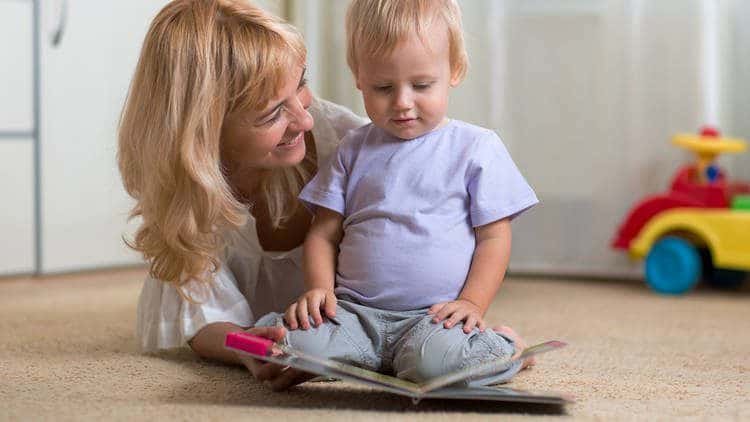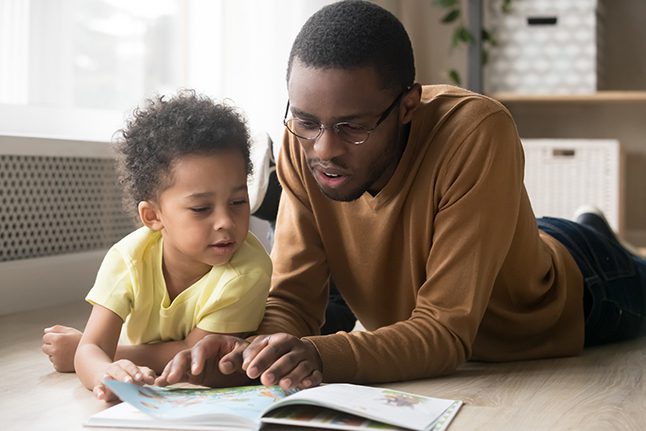Read Early and Often

You probably know that it’s important to read to children. You also may have heard that starting earlier is better. But maybe you feel a little silly reading aloud to an infant. Or you can’t figure out how to keep your 6-month-old from eating the corners of the book, or get your toddler to sit still and listen. We’ve all been there. So why read to babies? Although it seems babies are too young to enjoy being read to, they’re learning something new at every stage.
Why Read to Babies?
Reading together when babies are as young as 4 months old increases the chances that parents continue reading to babies as they get older. Beginning early is important because the roots of language are developing in a baby’s brain even before he can talk! The more words a baby hears over time, the more words he learns.
Reading: Ages and Stages
Here are some general guidelines for what types of books are a good fit from birth to 3, along with some can’t-miss parent tips for book-sharing in the early years. Letting a child love books in the ways he knows how at each age fosters literacy skills from birth to 3, and beyond!
| YOUR CHILD’S AGE | BOOKS FOR INFANTS | TIPS FOR PARENTS |
|---|---|---|
| Birth-6 Months | Go ahead and start reading chunky board books, soft fabric books, or vinyl bath books. | Why read to babies? Though a baby may seem too little to understand, she enjoys your company and the sounds of your voice and words. At this age, babies may come to recognize the book-sharing routine by calming, widening their eyes, or smiling and kicking to show excitement. Babies will also want to explore books through their senses by grabbing and chewing on the book. They may not pay attention to the whole story, so take a break when they get bored (looking away, arching back, closing eyes, crying). |
| 6-9 Months | Offer short, simple stories with colorful illustrations—board books are perfect. | Babies may begin to explore books by looking, touching (opening/closing), and mouthing them. By 9 months, they may prefer or seem to recognize certain stories or pictures. A baby may also continue to occasionally mouth books. In the early years, that is a normal book behavior and tells us that babies want to explore books! |
| 9–18 Months | Offer board books with simple stories. Stories with rhymes and phrases that repeat also catch a toddler’s attention. Children this age also love stories with pictures of other babies and familiar objects, such as animals. | A toddler may have a favorite story that she requests all the time. Starting at about 12 months old, you can start to ask simple questions about the pictures such as “Where is the moon?” and watch to see if the baby points or gestures. |
| 18–24 Months | Introduce longer stories (perhaps with paper pages, though supervise carefully) with more complex plots. Humor is a big selling point at this age, as are silly rhymes. | Don’t worry if a toddler runs away when you read—kids this age just really need to move. If you keep reading, he’ll keep listening, and he may come back to reconnect and hear more. Look for ways to connect that energy to the story, such as asking the child to hop like the rabbit in the book. The toddler might also be able to label objects with simple sounds or words, for example, exclaiming “Moo!” when he sees a picture of a cow. For new talkers, get in the habit of pausing before you say a favorite line or phrase in the story to see if a toddler will fill in the final word. Harness your toddler’s growing independence and give the child the “job” of turning pages. While reading, take some time to discuss what’s happening in the pictures and ask questions about the book such as “Who is hiding behind the tree?” This interaction helps to build a toddler’s thinking and language skills. |
| 24–36 Months | The child may be ready for books with regular pages and those that have an engaging plot (extra points for humor, rhymes, and great illustrations). Nonfiction stories—such as a book about construction vehicles, stories about animals or seasons, or books that discuss jobs such as doctor or mail carrier—are also of interest to toddlers who are working hard to figure out how the world works. | At this age, you can ask questions about the story that are a little tougher such as “How do you think the boy is feeling?” or “What do you think will happen next?” Make connections between the book and the child’s life by asking questions such as “The boy in this story played in the snow. What did you do in the snow this afternoon?” By 3 years old, a child may even be able to tell you the story based on what’s happening in the pictures. And don’t be surprised if the little one wants to hear the same book over and over. Toddlers still love repetition and won’t tire of a story, even the 7th time. |
Finally, remember that telling the child a story can happen any time. Give it a try during mealtimes, diaper changes, driving to child care, and right before bed when you “tell the story” of the child’s day. Each of these moments creates an opportunity to build a deeper connection with the child and to build her language and literacy skills, too!




